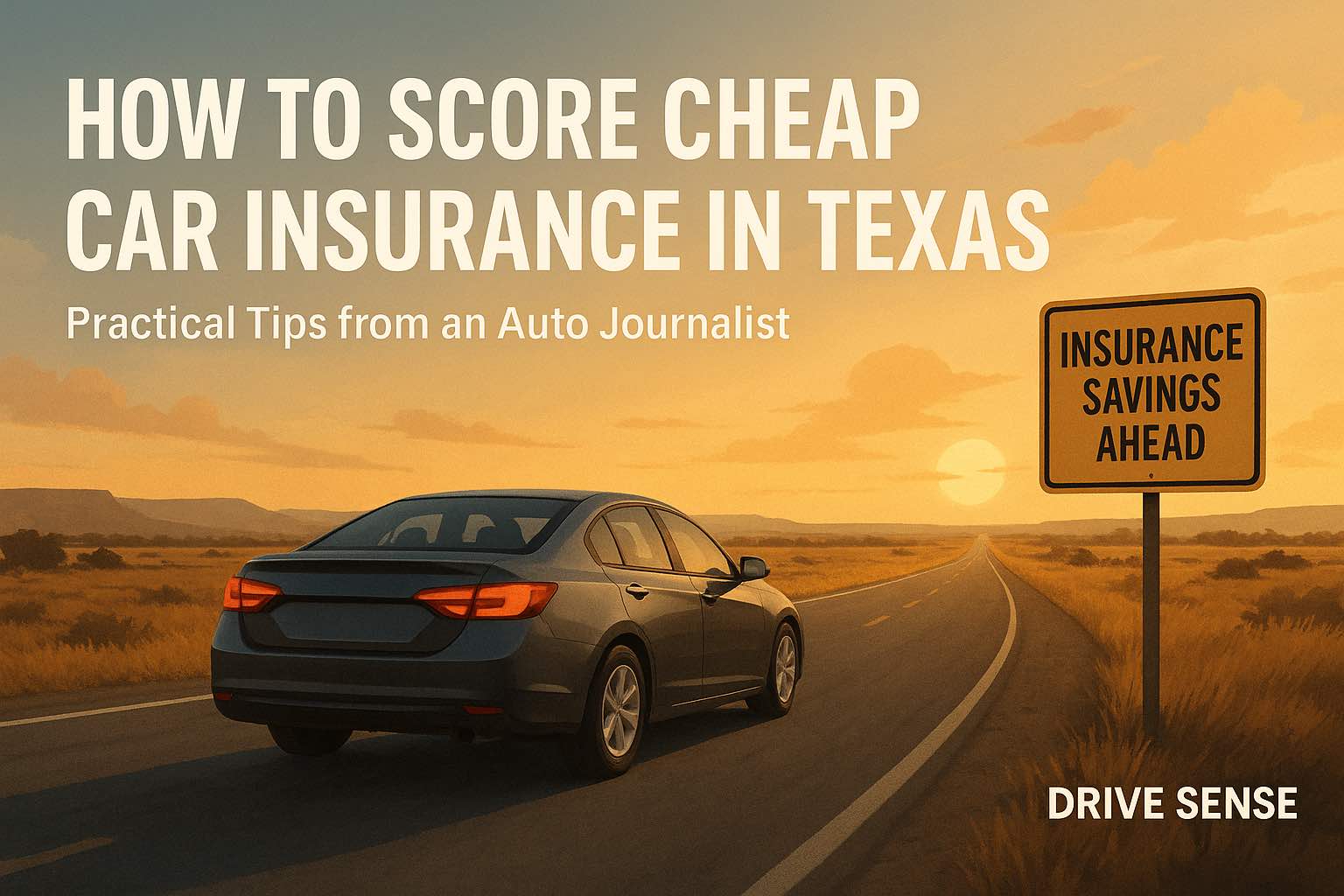Finding a Good Deal in the Lone Star State
There’s something about driving through Texas that’s impossible to replicate. Maybe it’s the vast, endless stretches of I-35, or the way the sun turns a simple commute into an epic journey. But behind every story on the open road lies a practical reality: car insurance. And in Texas, where everything really does seem bigger—including insurance premiums—finding cheap car insurance can feel like wrangling a steer with your bare hands. Let’s break down what actually works when you’re hunting for affordable coverage, from someone who’s spent more time than she’d like comparing policies and chatting with Texas drivers from Austin to Amarillo.
Why Texas Rates Can Make You Grit Your Teeth
If you’ve ever flinched at your renewal notice, you’re not alone. Texas is consistently ranked among the pricier states for car insurance. According to the National Association of Insurance Commissioners, the average annual premium hovers above the national average. Blame it on high traffic density in booming cities like Houston and Dallas, unpredictable weather (hailstorms, anyone?), and a legal climate that encourages higher liability claims. Add in uninsured drivers—Texas consistently ranks in the top tier for this unfortunate stat—and it starts to make sense why rates can be steep.
The Bare Minimum: What Texas Actually Requires
Before we get tactical, here’s what you must have by law: 30/60/25 liability coverage. That means $30,000 for injuries per person, $60,000 per accident, and $25,000 for property damage. This is non-negotiable; drive without it and you risk steep fines or even losing your license. Still, minimum coverage is just that—the absolute floor. If you have assets or drive something worth more than a used Tacoma, consider going higher.
Shopping for Deals: It’s Not All About Big Brands
Most folks start with household names—GEICO, State Farm, Progressive, Allstate. They’re all major players in Texas and often offer competitive rates. But here’s a tip: don’t ignore regional insurers like Texas Farm Bureau or Germania Insurance. Sometimes they quietly undercut the big guys, especially for drivers with clean records or those living in less congested areas. I’ve heard more than one Houston commuter swear by Farm Bureau’s low rates after ditching their national carrier.
Getting Quotes: The Real Workhorse
This part isn’t glamorous—think of it as the equivalent of digging through glove compartment receipts—but it pays off. Get at least five quotes before making a decision. Most companies have streamlined online tools now; you can punch in your info and get a ballpark number within minutes. Just be ready to answer detailed questions about your driving history, annual mileage (commuters beware), vehicle garaging location (zip code matters a lot), and even your credit score.
The Little Things That Shave Off Dollars
Here’s where things get interesting—and where minor life details can mean real savings:
- Bundle Up: Pair your car insurance with homeowners or renters coverage; many companies knock off up to 20%.
- Telematics Programs: Try letting your insurer monitor your driving via an app or plug-in device. If you brake gently and avoid late-night drives, you might see hefty discounts after a review period.
- Good Student Discounts: If you’re under 25 and can prove decent grades (usually a B average), most insurers will reward you.
- No Claims? Get Rewarded: A clean driving record over three years often triggers lower rates automatically—but ask for accident forgiveness if it’s offered.
- Pay Upfront: Paying six months or a year at once typically earns a price break compared to monthly installments.
- Low-Mileage Perks: If you work from home or keep mileage well below the average Texan (about 15,500 miles/year), report it—you might qualify for savings.
Bumping Down Premiums Without Sacrificing Coverage
I’ve sat behind the wheel of everything from cavernous Suburbans to featherweight Miatas in my career, but one thing stays true: smart coverage beats bare-bones every time. Still, there are ways to keep costs down without leaving yourself exposed:
- Raise Your Deductible: Bump up that deductible (the amount you pay out of pocket before insurance kicks in). If you rarely file claims and have some emergency savings set aside, this can lower your monthly bill by a surprising amount.
- Drop Unnecessary Extras: Roadside assistance or rental car reimbursement are nice but not essential if AAA already has your back or if you rarely rent cars.
- Avoid Small Claims: Minor fender bender? Sometimes it pays to cover it yourself rather than risk a rate hike that sticks around for years.
The Credit Score Factor: Not Just About Loans
This one stings if you’re rebuilding credit but it’s reality: insurers use credit-based insurance scores in Texas to set rates. A better score usually means a better premium—sometimes by hundreds per year. So if you’re working on improving your credit elsewhere (paying off cards, fixing errors), know that it’ll help your insurance situation too.
A Different Experience Behind Every Wheel
Your choice of ride makes more difference than most people expect. Insuring a RAM 1500 Crew Cab is pricier than covering an old Corolla—no surprise there—but some models defy expectations. For example, SUVs with advanced safety features often cost less to insure than flashy coupes with higher theft rates (hello Mustang GT). Even trims matter: adding factory security systems or lane assist tech could shave off dollars.
The Urban-Rural Divide: Where You Live Matters
I’ve always loved how crossing into West Texas feels like stepping into another world—the roads thin out and so do insurance premiums. Living outside Dallas-Fort Worth or Houston city limits can mean noticeably cheaper rates thanks to lower accident risk and theft rates. On the flip side? Densely packed urban neighborhoods almost always pay more—even if your car spends most nights tucked away in a garage.
Loyalty Isn’t Always Rewarded
This one surprised me when I first started researching: sticking with one insurer doesn’t guarantee better deals over time. In fact, some companies quietly raise rates on long-term customers who never shop around—a practice known as “price optimization.” Set yourself a calendar reminder to re-shop every year; it keeps insurers honest and often unlocks loyalty discounts with competitors eager for new business.
If You Hit Snags Along the Way…
If you’ve had accidents or tickets recently—or if you’re young and new behind the wheel—expect higher rates at first. But don’t lose hope; many insurers drop surcharges after three years of clean driving. Defensive driving courses approved by the state can also knock points off both your record and your premium; check with your provider before enrolling.
A Few Final Thoughts From Behind the Dashboard
Sifting through quotes may never be as thrilling as punching the accelerator on an empty Hill Country highway, but saving money on car insurance in Texas is absolutely doable if you approach it methodically—and ask lots of questions along the way. Remember that every detail matters: from how many miles you drive each year to which side of town you call home.
I’m Jessica Cole—writing this from my sun-drenched spot in Los Angeles but thinking back on muggy Austin afternoons spent poring over fine print and swapping stories with pickup truck owners outside Buc-ee’s.
If there’s one thing I’ve learned? The cheapest policy isn’t always the best fit—but taking control of your search means more freedom for those big Texas drives ahead.

